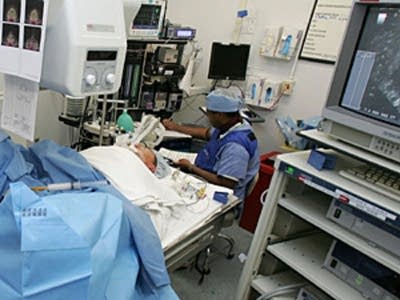Hospital errors up sharply in latest report
Go Deeper.
Create an account or log in to save stories.
Like this?
Thanks for liking this story! We have added it to a list of your favorite stories.

Minnesota tracks 27 types of adverse events. This year, serious bed sores, called pressure ulcers, were the most frequently reported adverse event. There were 48 cases. Foreign object cases were the second most reported event. Usually these are situations where a sponge, a piece of gauze or even a medical instrument is left in a patient after surgery. There were 42 such cases.
Health Commissioner Dianne Mandernach says while it may worry some people to see the number of these events go up, she suspects the increase is a sign that hospitals are getting better at tracking and reporting these events.
"And in doing that then the numbers go up. Now if we continue to see these numbers go up over a longer period of time, I think then we need to have a different discussion."
But Mandernach is careful not to minimize the effect of this year's increased errors either.
Turn Up Your Support
MPR News helps you turn down the noise and build shared understanding. Turn up your support for this public resource and keep trusted journalism accessible to all.
Hospital mistakes were blamed for 24 deaths and seven serious disabilities. Twelve of the deaths were attributed to preventable hospital falls by vulnerable patients.
We need to be very, very conscious of the fact that behind every one of these 154 events is a person. And in light of that, one is too many.
"We need to be very, very conscious of the fact that behind every one of these 154 events is a person. And in light of that one is too many. We cannot lose sight of these as numbers. There are people that stand behind this and we need to have a huge sensitivity to that," she says.
Mandernach says she's convinced that hospitals are taking the problem seriously and are looking for better ways to prevent medical errors. Minnesota Hospital Association President Bruce Rueben agrees. He says hospitals don't always understand why the numbers go up or down from one year to the next.
In the case of preventable falls, there were eight deaths reported statewide the first year. That number went down to three last year. This year it's up to 12. But Rueben says it doesn't mean that hospitals are ignoring the problem.
"Those numbers are so small that it's impossible to attach any kind of statistical significant to it. What's important is that we understand what we can do to prevent falls going forward. And I think that's exactly what we're doing," he says.
Rueben points to the Sioux Valley Tracy Medical Center in Tracy, Minnesota. The hospital recently implemented a new way to assess patients' risk of falling. He says the hospital has trained all of its staff, including housekeepers, to watch vulnerable patients. Rueben says as a result, the hospital reduced falls by 63 percent last year.
The University of Minnesota Medical Center, Fairview took a similar approach a few years ago after recording eight cases of foreign objects left in patients between 2003 and 2004.
Vice President for Patient Safety Alison Page says the hospital staff worked aggressively to solve the problem.
"They brought in experts in human factors science from the university and looked at their process and procedure, and moved to some standards around how things are counted, elimination of noise and interruptions when people are counting things, that have been very, very helpful. Since that time they've had no reported cases of retained objects."
But overall, Page says, the Fairview system did record slightly more foreign object cases this year due to incidents at some of their other hospitals. She says Fairview plans to pass on the lessons from its university hospital to those other facilities.
As part of this year's report, the Minnesota Department of Health is offering consumers a new guide that gives patients and families tips on how to work with health providers to make sure they receive safe care.
The department has also created an interactive Web site where consumers can check the safety record of specific hospitals and surgical centers.
Dear reader,
Political debates with family or friends can get heated. But what if there was a way to handle them better?
You can learn how to have civil political conversations with our new e-book!
Download our free e-book, Talking Sense: Have Hard Political Conversations, Better, and learn how to talk without the tension.




